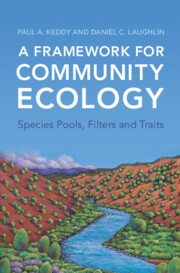Book contents
- A Framework for Community Ecology
- A Framework for Community Ecology
- Copyright page
- Contents
- Preface
- 1 A General Framework for Community Ecology
- 2 Filters
- 3 Species Pools
- 4 Traits
- 5 Trait–Environment Interactions
- 6 Functional Groups
- 7 Predictive Models of Community Assembly
- 8 Prospects and Possibilities
- References
- Index
1 - A General Framework for Community Ecology
Published online by Cambridge University Press: 18 November 2021
- A Framework for Community Ecology
- A Framework for Community Ecology
- Copyright page
- Contents
- Preface
- 1 A General Framework for Community Ecology
- 2 Filters
- 3 Species Pools
- 4 Traits
- 5 Trait–Environment Interactions
- 6 Functional Groups
- 7 Predictive Models of Community Assembly
- 8 Prospects and Possibilities
- References
- Index
Summary
There is a long history of describing communities in ecology. It is now time to develop a general predictive framework for this discipline. The goal is to simultaneously provide a consistent theoretical framework to guide research and a practical framework to guide conservation of wild landscapes. We propose that this framework has four key elements: the species pool vector P, the local community vector C, a vector of environmental filters E, and a vector of functional traits T. The central challenge of community ecology is to predict the species composition of any community C, using prior knowledge of P, E and T. Common filters include flooding, fire and herbivory. Each community C is a subset of the regional species pool P and is the result of filtering that matches species’ traits to the local environmental conditions. Dispersal, competition and time are also important in community assembly.
Keywords
- Type
- Chapter
- Information
- A Framework for Community EcologySpecies Pools, Filters and Traits, pp. 1 - 40Publisher: Cambridge University PressPrint publication year: 2021
- 1
- Cited by

